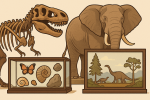Natural History Museums: Exploring the Wonders of Earth’s History and Biodiversity
Ever wondered about Earth’s epic story? Natural history museums house fascinating collections, from dinosaurs to dazzling minerals, revealing the secrets of our planet. Explore the wonders of evolution, biodiversity, and the intricate web of life. Discover hands-on exhibits, virtual reality adventures, and vital conservation efforts. Start exploring today!
Important information
- Natural history museums preserve collections of plants, animals, fossils, and minerals to showcase Earth’s history and biodiversity. They offer a look into the past and explain the evolution of life.
- These museums are centers for scientific research, contributing to fields like paleontology and ecology. Researchers use the collections to learn more about the natural world and guide conservation efforts.
- Interactive exhibits, educational programs, and special events help connect people with science. Museums offer hands-on activities, virtual reality experiences, and workshops to engage visitors of all ages.
- Museums play an active role in biodiversity conservation. They educate the public about environmental issues and support programs to protect endangered species and their habitats.
- Many museums offer virtual tours and accessibility features, making their collections and learning resources available to a wider audience, including people with disabilities.
Introduction to Natural History Museums
Natural history museums unveil Earth’s captivating story through diverse collections, from ancient fossils to vibrant plant life. Spanning geology, paleontology, biology, and anthropology, these exhibits let you explore our planet’s history, diverse ecosystems, and the evolution of life. Imagine encountering dinosaur skeletons, dazzling minerals, and exotic flora and fauna. These museums connect us to the natural world’s intricate web of life, illustrating humanity’s impact.
The Role of Natural History Museums
Natural history museums offer a fascinating glimpse into our world. They house incredible collections of fossils, minerals, plants, and animals, ranging from dinosaur skeletons to dazzling gems. These institutions shed light on Earth’s history and the mysteries of evolution.
Research
Beyond captivating displays, these museums play a crucial role in scientific research. Scientists use the collections to study biodiversity and deepen our understanding of the natural world.
Connecting with Science
These museums connect us with science by illustrating the intricate workings of ecosystems and the links between species and their habitats.
Their work extends beyond exhibitions, as they actively conduct research that informs conservation efforts. They also develop educational programs that champion sustainability and encourage environmental stewardship.
Understanding Earth’s History and Biodiversity
Natural history museums chronicle Earth’s story, showcasing its biodiversity through captivating exhibits. These displays illuminate the interconnectedness of life within ecosystems, emphasizing biodiversity’s vital importance and the urgent need for conservation.
Museum collections feature diverse items, bringing the past to life:
- fossils,
- minerals,
- plants,
- animals.
Visitors learn about:
- evolution,
- geological formations and ecological systems,
- the impact of human actions on biodiversity, fostering crucial environmental awareness.
Scientific Exploration and Discovery
Natural history museums are vital centers of scientific discovery, providing crucial resources for research in fields like paleontology and ecology. Their extensive collections of specimens and artifacts fuel investigations, leading to new breakthroughs. Beyond research, these museums offer engaging educational exhibits that make complex science accessible to the public. Visitors can explore everything from dinosaur skeletons to diverse ecosystems. Furthermore, museums frequently host special events that connect the community with science in exciting ways. These institutions play a vital role in both advancing scientific knowledge and fostering public understanding of the natural world.
Exhibitions and Interactive Experiences
Journey into the captivating realm of natural history museums, where dinosaur skeletons tower and ancient fossils whisper tales of bygone eras. Uncover the mysteries of human evolution and dive into the wonders of the ocean depths. Interactive exhibits engage visitors of all ages, sparking curiosity and wonder.
From fossils spanning millennia to meticulously preserved specimens, these museums boast collections of remarkable diversity. Explore interactive ecosystems and geological formations, embarking on a journey through the ages. Discover the intricate web of life that connects us all.
Many museums also delve into the fascinating story of human evolution and our profound impact on the environment—a critical issue in our modern world. Rotating special exhibitions often showcase cutting-edge research, highlighting biodiversity and the importance of conservation efforts. There’s always a new discovery waiting to be unearthed.
Dinosaur and Fossil Collections
Natural history museums showcase captivating dinosaur skeletons, offering visitors a glimpse into prehistoric life. Institutions like the Smithsonian boast extensive collections, featuring a wealth of fossils and impressive dinosaur exhibits that educate and inspire.
The Hall of Human Origins
Embark on a captivating exploration of human evolution at the Hall of Human Origins. Spanning millions of years, this exhibit showcases remarkable fossils and artifacts, key discoveries that illuminate our shared history and the fascinating path of human development.
Ocean Hall and Marine Life
Ocean Hall showcases the wonders of diverse marine ecosystems and highlights the crucial need for their conservation. Protecting our oceans is essential.
Interactive Exhibits and Activities
Interactive museum exhibits bring the natural world to life, engaging visitors with hands-on displays and activities. Through simulations and educational programs tailored to diverse learning styles, guests develop a deeper understanding of natural history. Interactive touchscreens offer captivating experiences, while virtual reality takes visitors on immersive journeys into various ecosystems. Aspiring paleontologists can even explore fossil digs. Here’s what you can experience:
- Hands-on exhibits, bringing the natural world closer.
- Educational programs designed for all learning styles.
- Interactive touchscreens for engaging exploration.
- Virtual reality journeys into different ecosystems.
- Fossil digs for budding paleontologists.
These activities make learning fun and memorable for everyone.
Biodiversity and Conservation Efforts
Natural history museums are crucial for biodiversity conservation, housing vast specimen collections essential for research and education. These collections provide a historical record of biodiversity, helping scientists understand complex ecosystems. Museums engage the public through exhibits and programs, raising awareness about conservation. They actively participate in conservation efforts by conducting research, supporting projects, and advocating for policy changes. For example, they demonstrate the interconnectedness of species and the impact of human actions, inspiring us to protect endangered species and their habitats.
Celebrating Earth’s Diverse Life
Natural history museums showcase the incredible biodiversity of plant and animal life on Earth, revealing the interconnectedness of all living things and emphasizing the critical importance of conservation.
Center for Biodiversity and Conservation
The Center for Biodiversity and Conservation transforms research into real-world conservation strategies, using its diverse expertise to support impactful programs and projects.
Transforming Knowledge into Conservation Action
Natural history museums translate complex research into practical conservation strategies, going beyond simply displaying exhibits. They educate the public about the serious threat of biodiversity loss and its widespread impact. Furthermore, these institutions actively engage in crucial habitat restoration and endangered species preservation, playing a vital role in safeguarding our planet.
Educational Programs and Resources
Natural history museums are incredible learning resources, offering educational programs that vividly bring the natural world to life. They offer engaging workshops and hands-on activities, along with frequent field trips. Scholarships and virtual tours expand access for diverse audiences, creating exciting opportunities for exploration and discovery.
Workshops and Hands-On Activities
Natural history museums offer engaging workshops and activities, providing hands-on experiences that connect visitors with the museum’s exhibits. Guests can dig for fossils, watch experts prepare specimens, and explore biodiversity through interactive programs. These activities make learning fun for all ages.
Field Trips and School Scholarships
Field trips offer invaluable learning experiences beyond the classroom. Scholarships make these enriching opportunities possible by removing financial barriers for schools, allowing more students to explore museums. At museums, students can delve into history, discover scientific wonders, and explore the world of art. While organizing transportation and planning these trips takes time and effort, the educational benefits are significant.
Virtual Tours and Accessibility
Virtual tours are revolutionizing museum experiences by bringing exhibits online. This digital access is crucial for accessibility initiatives, assisting people with disabilities through features like audio descriptions, closed captions, and interactive transcripts. These enhancements benefit everyone, fostering inclusivity and opening a world of art and culture to a broader audience. Museums are continually refining these online experiences, striving to make virtual visits both engaging and informative.
Public Engagement and Community Involvement
Natural history museums are transforming into dynamic community hubs, offering engaging spaces for public conversation and scientific exploration. They are partnering with local schools to provide students with hands-on learning experiences that boost science literacy. The museums also actively engage the community through lectures, film screenings, and special events, exploring fascinating scientific topics and encouraging discussions on crucial environmental issues. Furthermore, family-friendly activities and educational workshops make science approachable for everyone.
Community Engagement Initiatives
Natural history museums often partner with local schools, offering hands-on learning that boosts science literacy. They also host lectures, films, and special events, engaging the community with scientific topics like environmental issues. This fosters public discussion and exploration. Even smaller museums with limited resources contribute significantly to sparking scientific curiosity and educating future scientists.








